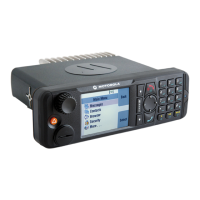
Do you have a question about the Motorola TETRA MTM5000 Series and is the answer not in the manual?
Compliance with FCC rules and requirements for radio operation and licensing.
Legal notices regarding Motorola Solutions' copyrighted computer programs and content.
Notes that features may not apply to all systems or may require specific licenses.
Explains graphic icons used in the documentation for visual clues.
Details special notations used in the text to highlight information.
Guidance on initial steps before powering on the radio for the first time.
Overview of the radio's physical controls and visual indicators.
Provides information on entering texts on your radio.
Details on enabling and using PIN code authentication for radio security.
Information on the radio's display elements and how they function.
Explanation of various icons that appear on the radio display indicating status.
Information on operating the radio in Trunked Mode, including infrastructure requirements.
Details on simplex radio communication directly between units without a network.
Procedures and guidelines for using the radio during critical situations.
Functionality for sending and receiving text messages, including inbox and outbox management.
How to manage contact entries, including creating, editing, and deleting.
Settings related to radio security, including PIN protection and keypad lock.
Customization options for radio settings like volume, display, and tones.
Creating and managing shortcuts to frequently used talkgroups and contacts.
Switching between different radio operation modes and network selections.
Enables GNSS, accuracy settings, and viewing radio position.
Allows dispatcher to listen to ambient sounds around the radio, preempting other calls.
Feature to receive alerts, interrupting services and attending to alerts.
Uses satellite information to determine radio's geographical location.